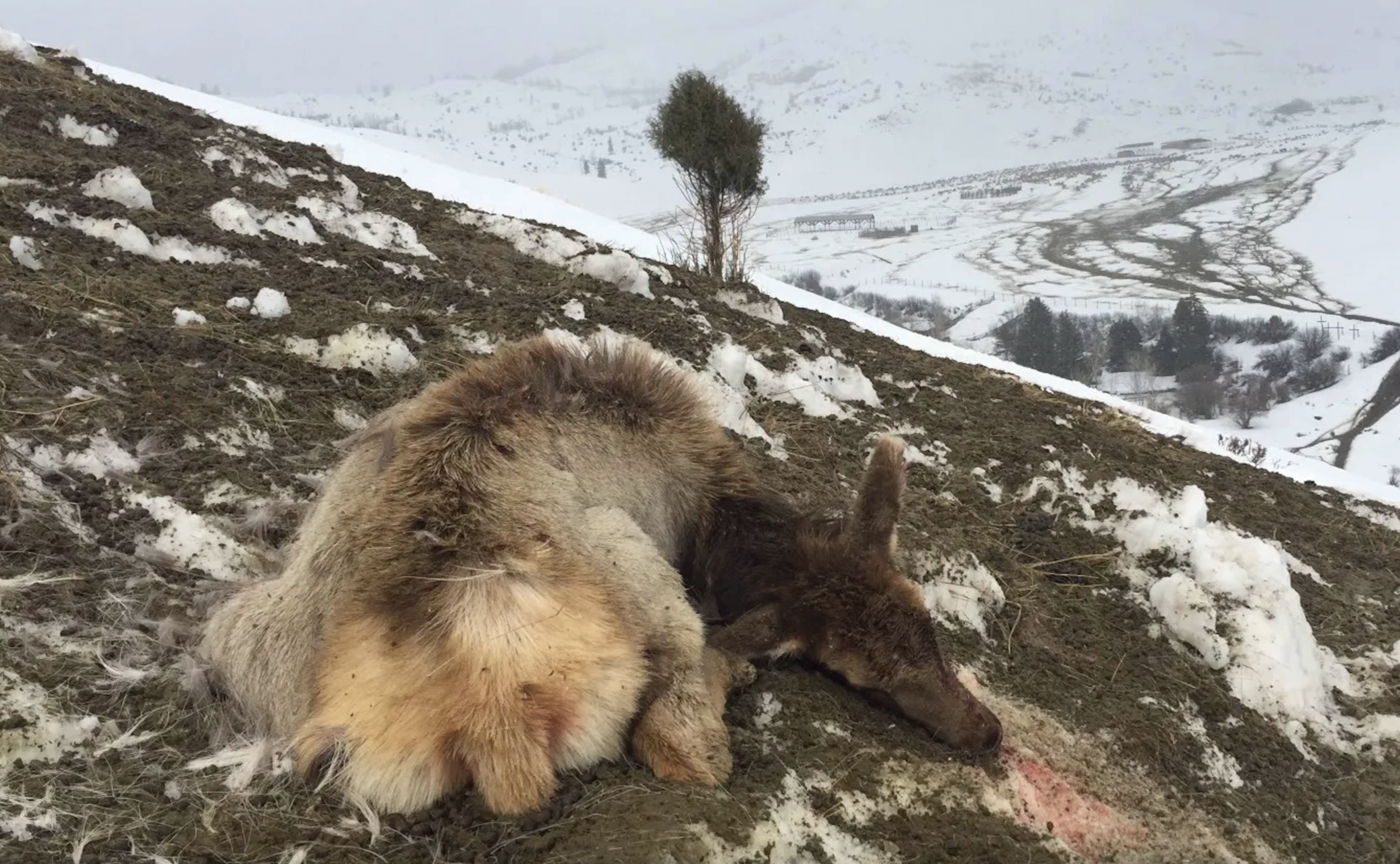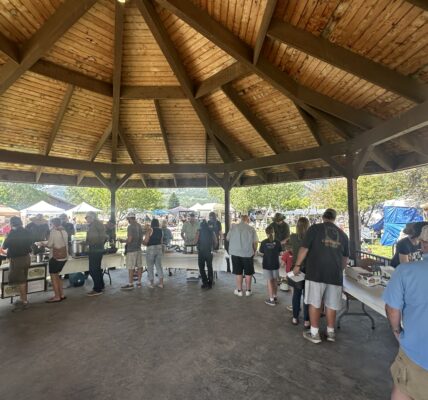Historic die-off at Wyoming elk feedground prompts management changes

• One of the largest documented outbreaks of hoof rot in Wyoming struck the Horse Creek Feedground last winter, killing nearly half of the congregated calves.
By Mike Koshmrl, WyoFile.com
Biologist Ben Wise received the first feedground reports of lethargic elk calves on Feb. 25.
He had a hunch about what was coming. As the Wyoming Game and Fish Department’s disease biologist for the Jackson Region, Wise has been around long enough to know what was likely about to happen. Hoof rot. And death.
There were too many elk on the Horse Creek Feedground where a feeder had spotted the sick juvenile ungulates: nearly 40% more than the 1,250-elk goal for the state-managed site just south of Jackson. The already long, cold and snowy winter would likely mean a long feeding season. That meant 1,733 elk being fed every morning on top of feces-filled ground in the feedground’s flat valley floor.
Hay mixed with alfalfa, which can cause mouth abrasions and lead to infections, was being distributed. The icy snow could do the same with hooves.
“Because of our feedground counts and because of the severity of the winter,” Wise said, “in early February I could tell we were going to see a hoof rot outbreak here.”
Hoof rot is the colloquial term for a disease caused by Fusobacterium necrophorum bacteria, which occurs naturally in ungulates’ guts. But when it gets into the bloodstream through an abrasion, it can be a killer — especially for calves, which have softer hooves and less robust immune systems.
For nearly two straight months after the first sighting, Wise fielded nearly daily reports of dead calves or lame calves needing to be euthanized.
“We stopped feeding there like April 15,” Wise said. “They were definitely starting to pile up at that point. Probably five to 10 animals a day were succumbing to it.”
The final toll was staggering: Nearly half of the calves counted on the Horse Creek Feedground last winter died.
Game and Fish did not publicize that deadly spate of hoof rot amid a devastating winter and spring for western Wyoming mule deer and pronghorn. But the state agency did detail the outbreak in its seldom-read “Job Completion Report” for Jackson Region ungulates released months later.
Major die-off
According to the report, 155 calves died or had to be killed on the Horse Creek Feedground, and “most” had to be killed by Wise and other wildlife managers “due to inability to move.” Another 64 dead calves suspected to have succumbed to hoof rot were discovered on the nearby Bridger-Teton National Forest or on private land. All told 45% of the calves counted on the Horse Creek Feedground died.
“That many calves is a huge percentage of the overwintering population,” Wise said.
Is that the largest hoof rot die-off documented in the nearly century-long history of Wyoming’s elk-feeding program west of the Continental Divide?
“I would guess it’s probably up there,” Wise said. “It’s not a new thing. Olaus Murie wrote about this in the 1930s, so it’s not something that just cropped up.”
Veteran biologist Eric Cole, who’s on staff at the National Elk Refuge, was also struck by the numbers.
“I’ve never seen anything of that magnitude,” Cole said.
There have also been major hoof rot-related losses on the nearby National Elk Refuge, which is managed by the U.S. Fish and Wildlife Service, but not at the same rates as the recent die-offs at the state-run feedgrounds. While there are more elk on the federal refuge — oftentimes more than 8,000, despite goals — there’s a lot more room to spread out feed on the federal property, which uses ground and pelleted alfalfa to feed elk instead of hay.
“We had regular fresh snow on the [federal] feedgrounds all winter long, and almost no melting until the end of the season,” Cole said. “So the animals basically we’re walking on clean snow for the entire winter.”
Winter 2022-’23 was a whopper, and relatively deadly by National Elk Refuge standards. Some 189 calves died, 19% of the surveyed population. But they died from a whole gamut of causes: predation, starvation, disease, etc.
“I can say that foot rot was relatively minor,” Cole said. “Only about 7% of calves that died were exhibiting signs of foot rot, and in previous years we’ve seen that [figure] as high as 80% of the calves that died.”
Overpopulation in the winter likely exacerbated issues at the Horse Creek Feedground.
Elk that gather there and at three other feedgrounds south of Jackson are part of the Fall Creek Herd, which summers in the northern Wyoming Range, Snake River Range, Gros Ventre Range and on ranchland straddling the Snake River. The herd as a whole is only 9% larger than Game and Fish’s 4,400-animal goal, but it’s the elk gathered at the hard-to-access Horse Creek Feedground that are most out of whack. Elk attending that site have exceeded the state’s goal 14 of the last 20 years, surpassing the objective by 55% as recently as 2021.
Hunter pressure lags
There’s no public road access to the feedground, and it’s proven tough to entice enough cow and calf hunters to trek three miles in to suppress numbers. This year, the state agency extended the season down there for over-the-counter “general” tag elk hunters later into November in hopes of increasing the kill.
Overall, there’s been a precipitous drop in hunter pressure on the Fall Creek Herd, according to Wyoming Game and Fish biologist Gary Fralick, who’s managed the herd for 30 years. He noted it’s the second largest elk population west of the Continental Divide in Wyoming, second only to the Jackson Elk Herd.
Fralick ran through the numbers for elk unit 84, which covers a lot of the Fall Creek Herd’s territory.
“From 2013 to 2022, we’ve seen an 83% decline in the number of harvested elk in area 84 by general license hunters,” Fralick said. “In 2013, general license hunters killed 345 elk. In 2022, they harvested 59.”
Fralick isn’t sure why hunter interest is so dramatically reduced. But it’s fallen off throughout the season, including a stark reduction in horse hunters headed into the backcountry. Fralick used to count between 55 and 65 trailers at the Bryan Flats trailhead (just across the highway from the Horse Creek Feedground) during the opening week of elk hunting. In recent years that figure has ranged from 11 to 14, he said.
“I wonder what it is?” said Fralick, who feels stumped by the shift.
Concurrent with the huge decline in hunting pressure, the Fall Creek Herd has become increasingly dependent on the four elk feedgrounds within its habitat: Camp Creek, Horse Creek, Dog Creek and South Park. That’s a dynamic that the neighboring Jackson Elk Herd shares.
Fralick has watched as the so-called “native range” outside of the feedgrounds in places like Munger Mountain and Grayback Ridge has steadily lost elk in the winter.
“That seems to be a bygone era,” Fralick said.
Instead of elk, what Fralick sees in those places now are the signs of human recreation: snowmobile and ski tracks. “It doesn’t take much to displace elk,” he said.
Fralick and his fellow managers have inherited a herd that’s more dependent on the feedgrounds — and, at Horse Creek, more susceptible to disease, like the necrobacillosis outbreak last winter.
Fix in the works?
The Wyoming Game and Fish Department, now partway through finalizing its first-ever elk feedground management plan, could soon have a new charter on how to respond to that and other diseases.
“I hope that the department is able to follow what has been written,” said Hank Edwards, Wyoming Game and Fish’s recently retired Wildlife Health Laboratory supervisor. “There are things that we can do to improve the welfare of those animals, so hopefully the department is able to do that.”
The draft plan calls for preventing hoof rot outbreaks by taking steps like feeding on clean snow and removing elk manure with a tractor. If a die-off does start, there’s another list of steps to take: reducing elk densities where possible, and euthanizing elk unable to stand.
Wise wants to avert another deadly outbreak.
“We’re going to do several alterations in the feeding regime at Horse Creek this winter to see if we can break that mortality cycle,” he said.
At the peak of the spring hoof rot die-off, he was dealing with putting calves out of their misery, handling dead elk, and trailering the carcasses away day after day.
“It definitely grinds on you,” Wise said. “My wife was like, ‘You were definitely not in a good place at the end of the winter.’”
As a precautionary measure for winter 2023-’24, Wise left a bunch of cut hay higher up on the state-owned land overlooking the traditional Horse Creek elk feeding site.
“It’s a big, open mesa where we can really spread the elk out,” he said. “Our goal this winter is to see if it’ll work.”
The state also stocked predominantly grass hay instead of alfalfa-mixed hay, he said, which could cut down on mouth abrasions that can lead to infection.
Last, there are likely to be fewer elk. That’s partly because of the later general season, which opens the door for heavier hunting, and partly a product of the last deadly winter.
“It’s sad to say, but one population management tool is not even a tool,” Wise said. “What’s managing the population now is calf mortality.”
WyoFile is an independent nonprofit news organization focused on Wyoming people, places and policy.






